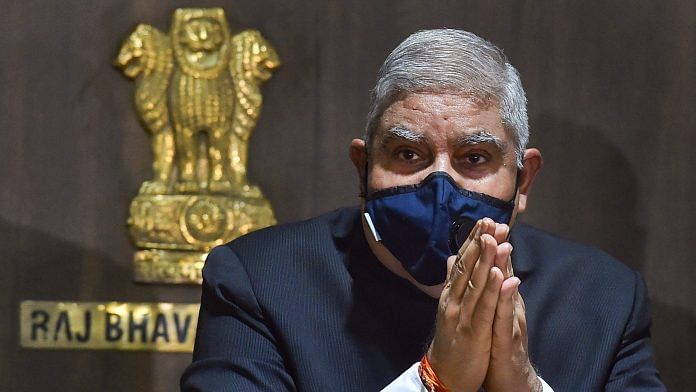West Bengal governor Jagdeep Dhankhar is in New Delhi and plans to meet Home Minister Amit Shah amidst the ongoing tug of war between him and Chief Minister Mamata Banerjee. The political contest between the Bharatiya Janata Party and the All India Trinamool Congress in West Bengal during the recently held assembly election seems to be turning into a constitutional slugfest between the chief minister and the governor.
The immediate provocation for the conflict appears to be the continuing post-poll violence targeting BJP workers and offices. The governor is duty bound to raise this issue and keep a tab on law and order. No doubt, the governor has to be very tactful and remain a constitutional head and avoid donning the administrator’s hat. But in the wake of unending violence, he has few options, and abdicating his duties is certainly not one of them.
On collision course
The state government has to act with all urgency and sincerity to stem the cycle of violence. Mamata Banerjee cannot overlook violence saying TMC workers are also under attack. Instead of questioning the governor about meeting the victims of violence, she could have deputed one of her top party functionaries to accompany him and presented a picture of unity against senseless killings due to political rivalry. This way she could have pre-empted the Narendra Modi government’s move to provide CISF security to BJP legislators, something that has been criticised for setting a wrong precedent.
Mamata Banerjee’s non-cooperation with the governor and the Union government sends the wrong signal and also affects the prospects of the state’s development. It will be pragmatic on her part to be magnanimous in victory and allow governance to have precedence over politics. On its part, the Centre too will have to learn to deal with such chief ministers who are strong state-level leaders. These non-Congress, non-BJP leaders have no all-India structure or apex body to report to. Since they do not report to any higher authority, they probably psychologically tend to show a certain level of independence and authoritarianism.
But getting entangled in micromanagement of the party and the state, reinstating police officers who could be considered close to the party ideology and entering into confrontations with the governor and the prime minister is showing the chief minister in poor light. Her absence from PM Modi’s review meeting to assess the damage caused by cyclone Yaas was an immature act, to say the least, prompting the Centre to recall former state Chief Secretary Alapan Bandyopadhyay. Both the Centre and the state are now on a collision course at the cost of West Bengal’s development.
Also read: PM has no individual powers under NDMA. Notice to Alapan Bandyopadhyay questionable
West Bengal suffers
West Bengal has great potential for economic growth and improving its industrial and agricultural output. No other state in India has probably seen repeated partitions, political and economic setbacks, and has been at the epicentre of intense dogmatic rivalry and political violence as much as West Bengal. From being the capital of the British Raj, Bengal became a marginalised underdeveloped state due to a number of local and external factors. Under the 34 year-long Communist rule, West Bengal became an industrially and agriculturally backward state. The only contribution was in terms of hartal and “cholbe na cholbe na” slogans. The Trinamool Congress, which wrested power from the Communists, seems to have changed nothing.
After the 1977 assembly election, when the CPM won 178 seats and registered a decisive win over the Congress, which was reduced to a mere 20, the ‘grand old party’ maintained an average of 40 seats in subsequent elections. In the 2011 election, the TMC got 184 seats while both CPM and the Congress got about 40 seats each. The fact that elections in West Bengal have become a two-party contest is very clear. The CPM displaced the Congress, and the TMC filled the space vacated by the CPM. Mamata Banerjee is aware of the fact that with 70 seats in 2021, it is a matter of time before the BJP prepares a strategy to displace TMC in the next election. Time is not on her side. The BJP seems to have perfected the art of winning elections and snatching victory from the jaws of defeat.
The West Bengal Chief Minister should recognise that the BJP has made a dent in her vote bank and party too. It is true that some of the TMC members who switched over to the BJP before and during the election are finding their way back to TMC offices in a ‘ghar wapsi’ programme. Such elements were of no use to the BJP nor will they be of any use to the TMC. They are crudest examples of the ‘aaya Ram, gaya Ram’ variety that almost all parties in India have witnessed and experienced.
But it cannot be denied that the TMC does have persons of integrity and calibre who can exhibit exemplary performance if allowed a free hand. State Finance Minister Amit Mitra who headed an industry association is one example. The talent of the former railway minister who is now in the BJP was not put to good use. Mamata Banerjee should rethink her priorities and try to provide strong and stable governance.
Seshadri Chari is the former editor of ‘Organiser’. Views are personal.
(Edited by Neera Majumdar)



